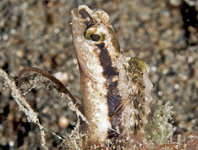Abstract
A new carabid beetle genus, Balligratus gen. nov., belonging to the tribe Lachnophorini, is described. It is geographically restricted to the equatorial Andes, and ecologically linked to the montane pluvial forest ecosystem, at elevations ranging from 1,200 to 3,600 m. As other carabid lineages that have radiated in such environments, Balligratus gen. nov. is a wingless clade, characterized by the loss of flight wings associated with metathoracic reduction, constriction of the elytral base, and reduced eye size. This evolution is unique among Lachnophorini. Four new species are described, all of them from Ecuador: Balligratus brevis sp. nov., Balligratus globosus sp. nov., Balligratus gracilis sp. nov. and Balligratus humerangulus sp. nov.
References
Ball, G.E. & Bousquet, Y. (2000) Carabidae Latreille, 1810. In: Arnett, R.H. Jr. & Thomas, M.C. (Eds.), American beetles. Vol. 1. Archostemata, Myxophaga, Adephaga, Polyphaga: Staphyliniformia. CRC Press, Boca Raton, Florida, pp. 32–132.
Bates, H.W. (1871a) Notes on Carabidae, and descriptions of new species (No. 5). Entomologist’s Monthly Magazine, 8, 29–34.
Bates, H.W. (1871b) Notes on Carabidae, and descriptions of new species (No. 8). Entomologist’s Monthly Magazine, 8, 102–106.
Bates, H.W. (1872) Notes on Carabidae, and descriptions of new species (No. 12). Entomologist’s Monthly Magazine, 8, 199–202.
Erwin, T.L. (2004) The Beetle Family Carabidae of Costa Rica and Panamá: Descriptions of four new genera and six new species with notes on their way of life (Insecta: Coleoptera). Zootaxa, 537, 1–18.
https://doi.org/10.11646/zootaxa.537.1.1Erwin, T.L. & Zamorano, L.S. (2014) A synopsis of the tribe Lachnophorini, with a new genus of Neotropical distribution and a revision of the Neotropical genus Asklepia Liebke, 1938 (Insecta, Coleoptera, Carabidae). ZooKeys, 430, 1–108.
https://doi.org/10.3897/zookeys.430.8094Josse, C., Cuesta, F., Navarro, G., Barrena, V., Cabrera, E., Chacón-Moreno, E., Ferreira, W., Peralvo, M., Saito, J. & Tovar, A. (2009) Ecosistemas de los Andes del norte y centro. Bolivia, Colombia, Ecuador, Perú y Venezuela. Secretaría General de la Comunidad Andina, Lima, 96 pp.
LeConte, J.L. (1853) Notes on the classification of the Carabidae of the United States.Transactions of the American Philosophical Society, Series 2, 10, 363–403.
https://doi.org/10.2307/1005287Liebherr, J.K. (2016) Cyphocoleus Chaudoir (Coleoptera, Carabidae, Odacanthini): descriptive taxonomy, phylogenetic relationships, and the Cenozoic history of New Caledonia. Deutsche Entomologische Zeitschrift, 63 (2), 211–270.
https://doi.org/10.3897/dez.63.10241Liebke, M. (1938) Denkschrift über die Carabiden-Tribus Colliurini. In: Festschrift zum 60. Geburtstage von Profesor Dr. Embrik Strand. Vol. 4. Izdevniecība Latvija, Riga, pp. 37–141.
Moret, P. (1990) Volcanisme et spéciation dans les Andes: à propos de deux nouveaux Dyscolus orophiles [Col. Caraboidea Platyninae]. Bulletin de la Société entomologique de France, 95 (5–6), 169–174.
Moret, P. (2005) Los coleópteros Carabidae del páramo en los Andes del Ecuador. Sistemática, ecología y biogeografía. Pontificia Universidad Católica del Ecuador, Centro de Biodiversidad y Ambiente, Monografía 2, 1–306.
Moret, P. & Toledano, L. (2002) Ecuadion, nouveau sous-genre de Bembidion Latreille du páramo équatorien (Coleoptera, Carabidae, Bembidiini). Bollettino del Museo Civico di Storia Naturale di Venezia, 53, 155–205.
Ober, K.A. & Maddison, D.R. (2008) Phylogenetic relationships of tribes within Harpalinae (Coleoptera: Carabidae) as inferred from 28S ribosomal DNA and the wingless gene. Journal of Insect Science, 8 (63), 1–32.
https://doi.org/10.1673/031.008.6301

